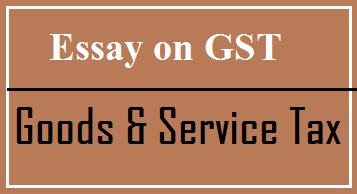Essay on GST| GST Essay UPSC Goods & Service Tax in English
Essay on GST| GST Essay UPSC Goods & Service Tax in English For Students

Essay on GST| GST Essay UPSC Goods & Service Tax in English: Goods and Service Tax, commonly known as GST, is a comprehensive, destination based and multistep indirect tax levied n supply of goods and services in India. It eliminates most of the indirect tax except few of the state taxes. The tax is imposed at every level of production, but it is destined to be returned back to all the parties of the level of production, excluding the final consumer. It is different from the earlier taxes as it is collected from level of consumption, not production.
Essay on GST| History and Implementation
During the Prime Minister ship of Rajiv Gandhi, Finance Minister, Vishwanath Pratap Singh, introduced Modified Value Added Tax. In 1999, Prime Minister Atal Bihari Vajpayee, along with his advisory panel, proposed a common tax, named as Goods and Service tax, which received a green signal to go ahead with.
Asim Das Gupta Committee was made for the same and it made GST Network, commonly known as GSTN. Since then, the proposal can’t be passed because of political constraints.
However, in May 2016, under the Modi Government, Constituent Amendment Bill was passed by Lok Sabha, after the introduction of Bill by Arun Jaitley, then Finance Minister.
A committee was formed to look after the bill and the bill was enacted as law in April 2017 by both the houses of Parliament. The GST was launched by the President of India at midnight of 1st July 2017. The members of Congress and some other parties opposed the act by claiming that current government is just rebranding the existing taxation policy.
Essay on GST| Tax Details| Goods & Service Tax: GST
The single tax eliminates several major taxes including Central Excise Duty, Service Tax, Surcharge and Value Added Tax. GST is levied for all the transactions like Purchase, Sales, Transfer, and Lease etc. Our Government adopted dual model of GST, wherein administration department is distributed among state and central Government.
The GST is classified on the basis of place of transfer of goods and services. The transactions done within the boundary of state, i.e., the intra-state transactions, are levied with Central GST (CGST) & State GST (SGST) in equal ratio by Central and State Government respectively. For interstate transactions however, the Central Government levies Integrated GST (IGST) on goods and services. Herein, the tax is levied on the place of consumption, not production.
HSN codes are provided to each commodity for systematic working and global acceptance. The rate of GST varies from commodity to commodity. The tax slab consists of five different rates of 0%, 5%, 12%, 18%and 28%. Petroleum and its products along with alcohol are excluded from the GST regime. A paperless solution was implemented under the name of E-bill, to control the tax leakage in case of interstate transactions.
The company needs t be registered under the GST regime in order to receive the Input Tax Credit. There is a mechanism of reverse charge, where the receiver is eligible for the Input tax credit, but the unregistered dealer will not be eligible for the same.
GST Council and GST Network
A council of 33 members is made as a governing body to modify, procure or reconcile any regulation or law based on GST. It is headed by Finance Minister and is responsible for any revision of rules or enactment of rules, or rate changes in GST.
Goods and Service Tax Network or GSTN, is developed to ensure the availability of single online portal to access information by taxpayers, stakeholders and Government. It is a nonprofit organization wholly owned by Central and State Government with equal shares.
Criticism
The GST is consumption tax which supersedes most of the indirect taxes and has helped in dropping down of travel time in interstate transactions. However, the enactment of GST is opposed not only by internal political parties, but global financial institutions and media.
World Bank considers it complex as compared to other countries and saw several flaws in it. It is further looked down because of more administrative jobs, more documentation and refund delays. The opposition parties expressed their discomfort with the help of media and public addressing.
Important Links
Essay on Make in India for Students, Childs